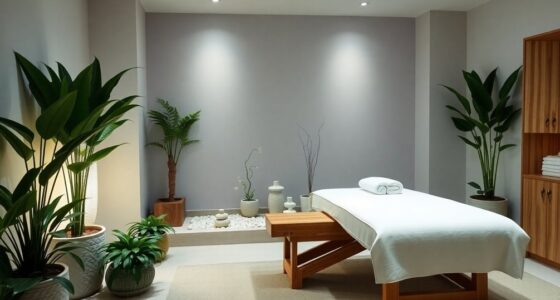Modern and contemporary design styles both create sleek, functional spaces, but they have distinct roots and features. Modern design, emerging in the early 20th century, emphasizes minimalism, geometric shapes, and neutral palettes with industrial materials. Contemporary style is more fluid, blending current trends, softer colors, and diverse textures for a warm, inviting feel. To tell them apart and discover how to incorporate each into your space, explore the key characteristics and differences described below.
Key Takeaways
- Modern design emphasizes geometric shapes, minimalism, monochromatic palettes, and early 20th-century influences.
- Contemporary style features fluid forms, bolder colors, mixed textures, and current global trends.
- Modern spaces prioritize sleek, industrial materials like glass and polished concrete; contemporary incorporates natural textures like wood and stone.
- Modern decor is more structured and monochromatic, while contemporary blends diverse textures and softer tones.
- Cultural origins differ: modern rooted in Western industrialization; contemporary draws from diverse global influences.
Origins and Historical Context of Modern and Contemporary Design

Have you ever wondered how modern and contemporary design evolved from their roots? The historical evolution of these styles reflects shifting cultural influences over time. Modern design emerged in the early 20th century, inspired by the desire to break away from ornate, traditional aesthetics, emphasizing simplicity and functionality. It was shaped by movements like Bauhaus and Modernism, which valued industrial materials and clean lines. Contemporary design, on the other hand, continues to adapt, influenced by global cultures, technological advances, and sustainability concerns. It’s more fluid and dynamic, often blending styles and experimenting with new forms. These styles are deeply rooted in cultural influences that mirror society’s changing tastes, values, and technological progress, creating a rich, evolving history that shapes how we experience spaces today. Additionally, sound healing science demonstrates how our environment can influence emotional well-being, echoing the importance of design in shaping human experiences.
Defining Characteristics and Visual Elements

Modern and contemporary design each have distinct visual signatures that set them apart, yet they also share some overlapping characteristics. You’ll notice both styles favor clean lines and open spaces, but their approaches differ. Modern design often features geometric patterns and minimalist decor, emphasizing simplicity and functionality. Contemporary design, on the other hand, is more fluid, incorporating evolving trends and a mix of textures. Both styles tend to favor neutral color palettes, but modern designs lean toward monochrome, while contemporary styles may introduce bolder accents. Their shared focus on uncluttered aesthetics creates a sleek, sophisticated look. Ultimately, understanding these visual elements helps you identify and incorporate each style’s unique charm into your space. Incorporating antiques thoughtfully can add character and depth to either design style, blending history with modern aesthetics.
Material Choices and Color Palettes
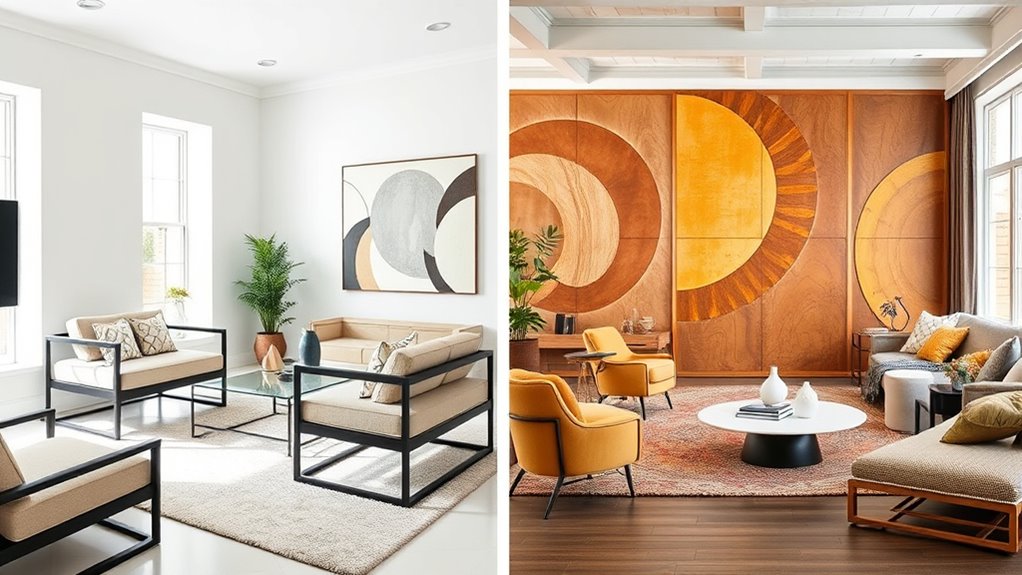
Ever wonder how material choices and color palettes shape the overall feel of a space? The material influence plays a pivotal role in defining a design style. Modern spaces often feature sleek, smooth materials like glass, metal, and polished concrete, emphasizing simplicity and functionality. Contemporary designs, on the other hand, tend to mix textures such as wood, textiles, and natural stone, creating warmth and visual interest. Color symbolism also guides your choices; bold, monochromatic palettes evoke a sense of sophistication and minimalism typical of modern styles. Conversely, contemporary designs embrace varied hues and softer tones, fostering a welcoming atmosphere. Your selections in materials and colors directly influence the mood, making your space feel either crisp and refined or comfortable and inviting. Additionally, understanding typical beauty store hours can help you plan your shopping trips efficiently while sourcing these design elements.
Furniture and Accessory Styles
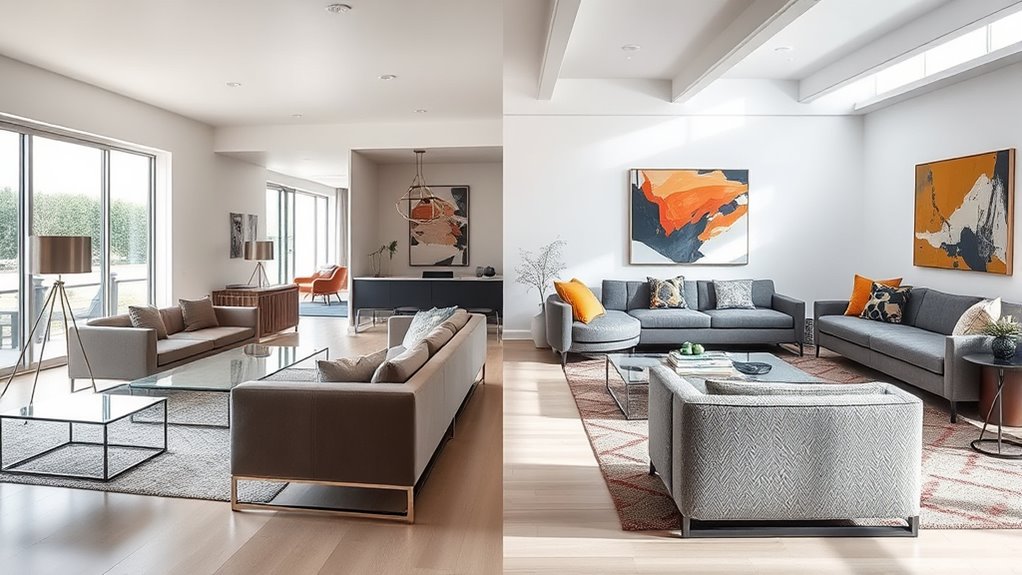
Furniture and accessories are indispensable tools for expressing and reinforcing a design style. In modern spaces, you’ll find furniture with sleek lines, minimal ornamentation, and functional forms. Contemporary styles emphasize comfort and practicality, often featuring bold decorative motifs and innovative lighting techniques that highlight key pieces. Accessories like abstract artwork, geometric rugs, and statement lighting fixtures serve as focal points. You might incorporate modular furniture for flexibility or use sculptural decor to add visual interest. The key is balancing form and function, ensuring each item complements the overall aesthetic. Incorporating textile and accessory elements such as cozy textiles or handmade ceramics can further enhance the style and create a warm, inviting atmosphere. Remember, lighting techniques and decorative motifs play a crucial role in defining the ambiance and character of your space, whether you lean toward modern or contemporary styles.
Incorporating Modern and Contemporary Aesthetics Into Your Space
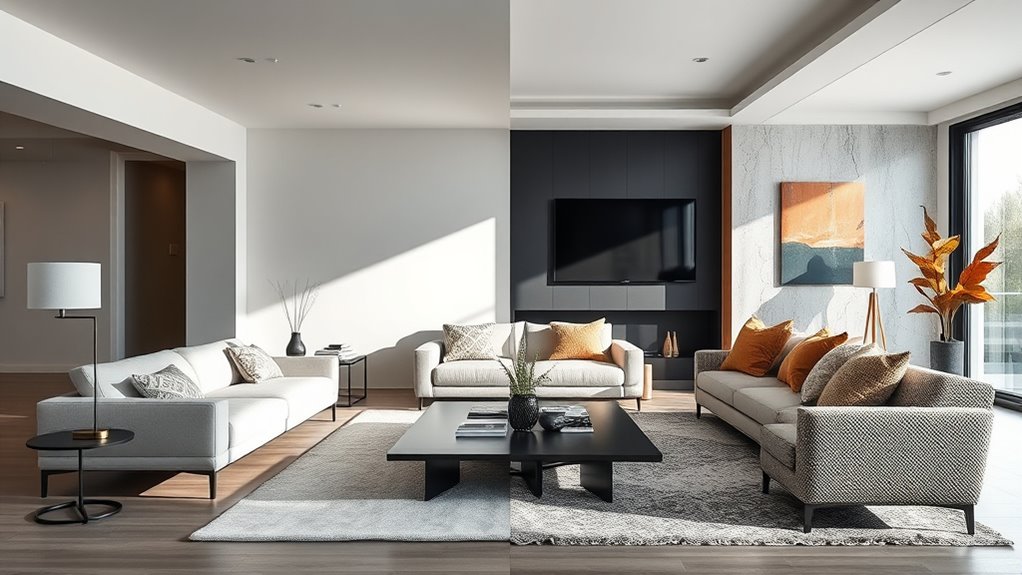
To successfully incorporate modern and contemporary aesthetics into your space, focus on selecting sleek, streamlined furniture that emphasizes clean lines and minimal ornamentation. These styles celebrate artistic expressions through bold shapes, neutral palettes, and functional designs. Incorporate cultural influences subtly—think globally inspired textiles or artwork that reflect diverse traditions—adding depth without clutter. Use open layouts and uncluttered surfaces to create a sense of spaciousness and simplicity. Lighting plays a pivotal role; opt for fixtures with geometric forms or minimalist finishes. Modern and contemporary designs thrive on contrast and simplicity, so avoid overly ornate details. By blending artistic expressions with cultural influences, you craft a space that feels both stylish and meaningful, embodying the essence of these sleek, forward-thinking styles.
Tips for Distinguishing Between the Two Styles
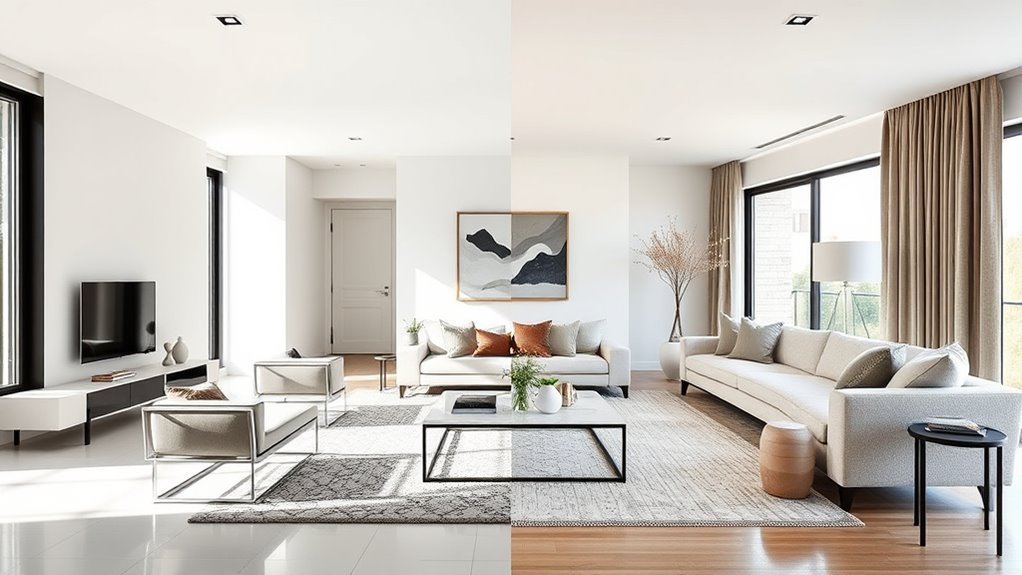
How can you tell the difference between modern and contemporary design styles? It often comes down to artistic influences and cultural origins. Modern design reflects the early 20th-century movement emphasizing clean lines and minimalism, rooted in Western industrialization. Contemporary style, on the other hand, is ever-evolving, drawing inspiration from current trends worldwide, often blending various cultural influences. To distinguish them, consider these tips:
- Modern uses a neutral color palette, while contemporary may feature bold hues.
- Modern emphasizes simplicity; contemporary mixes textures and patterns.
- Artistic influences in modern design stem from Bauhaus and Scandinavian roots, whereas contemporary often incorporates global art styles.
- Modern architecture has geometric shapes; contemporary embraces asymmetry.
- Cultural origins of modern are historically grounded, while contemporary adapts to modern tastes.
- Additionally, design elements such as natural materials and vintage decor are hallmarks of farmhouse style, which can influence either modern or contemporary interiors.
Frequently Asked Questions
How Do Modern and Contemporary Design Influence Sustainable Interior Practices?
You can see how modern and contemporary design influence sustainable interior practices through their emphasis on sustainable materials and eco-friendly furniture. Both styles prioritize minimal waste, energy efficiency, and renewable resources, encouraging you to select eco-conscious options. This approach helps reduce environmental impact, promotes healthier living spaces, and supports eco-friendly brands. By integrating these design principles, you actively contribute to a more sustainable future while creating stylish, functional interiors.
Can Modern and Contemporary Styles Be Blended Within a Single Space?
You can definitely blend modern and contemporary styles within a single space through hybrid design and style integration. Focus on balancing clean lines and sleek features from modern design with the softer, more flexible elements of contemporary aesthetics. Mix textures, materials, and furniture pieces thoughtfully, creating a cohesive look that highlights both styles’ strengths. This approach allows for a personalized, dynamic space that feels fresh and harmonious.
What Are Common Misconceptions About Modern and Contemporary Design?
You might think modern and contemporary design are the same, but they often get misunderstood. Many believe both styles strictly follow a minimalist approach, but contemporary design can be more fluid and eclectic. Also, some assume they lack historical references, yet modern design emphasizes simplicity rooted in history. Recognizing these misconceptions helps you appreciate the unique qualities of each style and creates more intentional, harmonious spaces.
How Do Cultural Influences Shape Modern and Contemporary Aesthetics?
Cultural currents craft enthralling contours in modern and contemporary aesthetics, shaping spaces with symbolism and regional resonance. Your choices reflect cultural symbolism, blending tradition with trend, transforming environments into expressions of identity. Regional aesthetics influence materials, colors, and forms, echoing local landscapes and histories. By embracing these cultural influences, you create designs that celebrate diversity, connect communities, and tell stories rooted in heritage, making your space uniquely vibrant and meaningful.
What Role Do Lighting Choices Play in Distinguishing These Styles?
Lighting choices help you define the mood and highlight design elements, making them key in distinguishing styles. Modern spaces often feature sleek, minimalist fixture selection with clean lines, creating a bright, functional lighting ambiance. In contrast, contemporary settings may incorporate bold or sculptural fixtures that add visual interest, adjusting the lighting ambiance for a more dynamic feel. Your selection of fixtures directly influences the overall aesthetic and atmosphere of your space.
Conclusion
Now that you know the differences between modern and contemporary design, you can confidently choose the style that best reflects your personality. Will you embrace the sleek simplicity of modern design or the ever-evolving vibe of contemporary? Remember, blending elements from both can create a space that’s uniquely yours. So, why not experiment and see which aesthetic feels most like home? After all, your space should be a true reflection of you.



